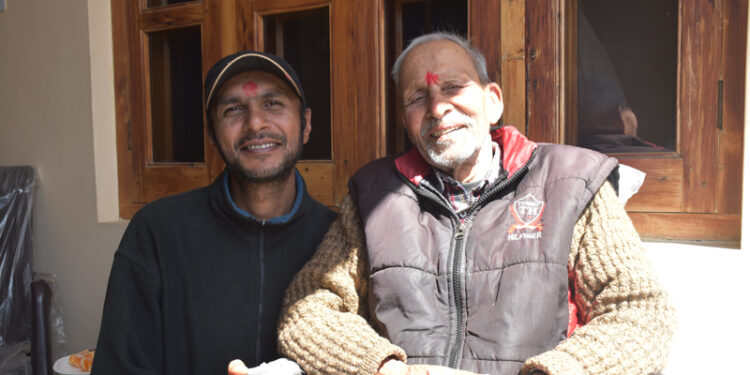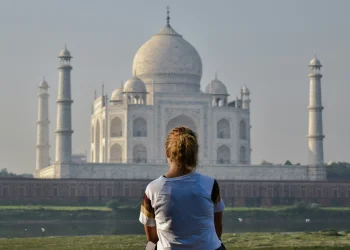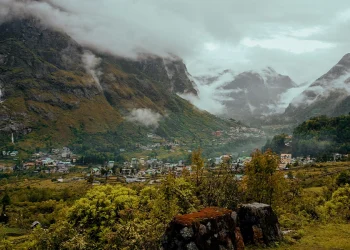(By Rishi Sood)
It’s unfortunate that this article had to come like this, but we consider ourselves most blessed to be among those who met him in person, and interviewed him over oranges and giggled over tea. The Traveller Trails pays its tribute to the legend of the folklorist of Chamba Sh.Kamal Prasad Sharma.
Fall 2017 marked the first issue of The Traveller Trails highlighting the colourful and the divergent town of Himachal Pradesh, Chamba. The team travelled to the region, to meet in person, the people associated with music, culture, costumes, dances, pilgrimages and the archeology of the town, which is so exotic.
Among all the eminent personalities, and places of the region, there was one such personality who already had been a significant influence on me, during my travels in Chamba when I first started exploring the region. I was on cloud nine on hearing that we would be interviewing him (Sh. Kamal Prasad Sharma), as he was a renowned person for all region specific knowledge.
Born in 1934 at Chamba, to a renowned family, he did his secondary schooling in Chamba and later gained a Pharmacy certificate, (insisting he did not have any formal degree in the medical field). This combined with his association with the local Dramatics club and Sanatan dharma, laid the foundations for his future works.
As an accomplished writer/director, he directed some famous folklores like “BALIDAAN” (The sacrifice made by the Queen of Chamba, with her life, to bring water to the drought hit town; was commemorated) and “MANJARI-MAHOTSAVA” new name Minjar Fair (immortalizes the triumph of the Raj of Chamba over Raj of Trigarta, the celebration of paddy and maize crops.) He was also a decipherer, deciphering the cryptograms on stones, wood and carving on temples around Chamba.
It was historian Padamshri Jagdish Mittal and later, Prof Maithili Prasad Bhardwaj who encouraged him to carry forward his research and publish his work in the form of art and culture of Chamba, which eventually proved to be the catalyst required to fulfil his dream, when in the 90’s Indus Publication House requested him to write a 3 part series on Chamba culture, divided into musical instruments, costumes, ornaments and dances of Chamba.
The dream he sowed in the 70’s was eventually fulfilled in 1992 when the first part of the series was published. “BIUNSALI” came out highlighting musical folk instruments of Chamba with special reference of the rarely used ‘chordo-phonic’ instruments by Musadha or musadi (one who simultaneously plays the instrument with narratives) and Aichali singers (a form of local singing where songs are sung in praise of Shiva and folk lore’s are recited) was made.
In 1997 along with S.M. Sethi the second part of the series was published titled “Costumes and Ornaments of Chamba”. In the year 2000 he gave us his fine work on the mythical archeological Treasure of Chamba, in the form of “Manimahesh Chamba Kailash” which highlighted the splendour of this ancient Gaddi (shepherd) kingdom called Bharmour to the rest of the world. His third book in the series “Folkdances of Chamba” in 2004, outlined the opulent information in the field so far. “Rediscovering Chamba” with Swapan Mahajan in 2005 still serves as a guide to travelers visiting the region. “Deep in the Chamba Himalayas” and “Vadiyaan in the Chamba “remains as an unpublished work of his.
In 2006 he was honoured by the then Union Minister of Tourism and Culture Ambika Soni.
In response to our question on inspiration he said “There is no inspiration; it’s your furore which make them real”, and I’m sure in his heart he knew what he had achieved.
On the morning of 07 April 2018 at age 84 years, he breathed his last in his hometown Chamba. He will be remembered in our hearts as a folklorist, a writer, Litterateur, decoder, and a heritage historian who documented the cultural Chamba.

Founded in 2016, The Traveller Trails is a print and digital magazine and a trusted source for current news, trends, analysis, opinions, interesting blogs, videos and exclusive interviews from every corner of the world.












